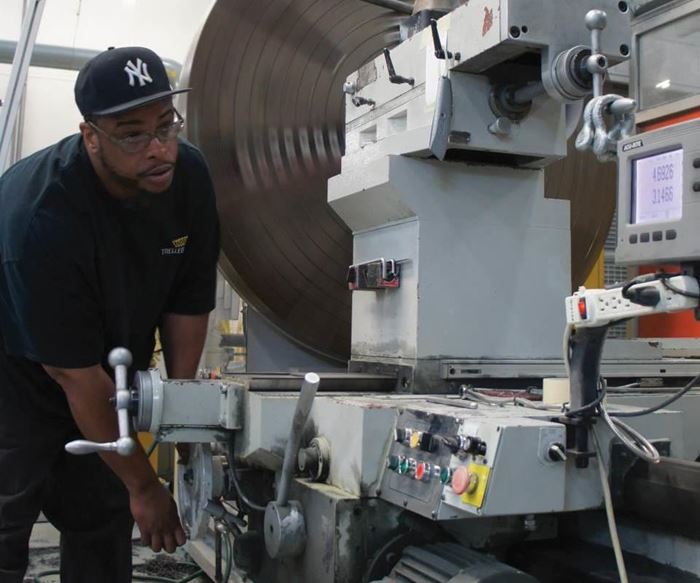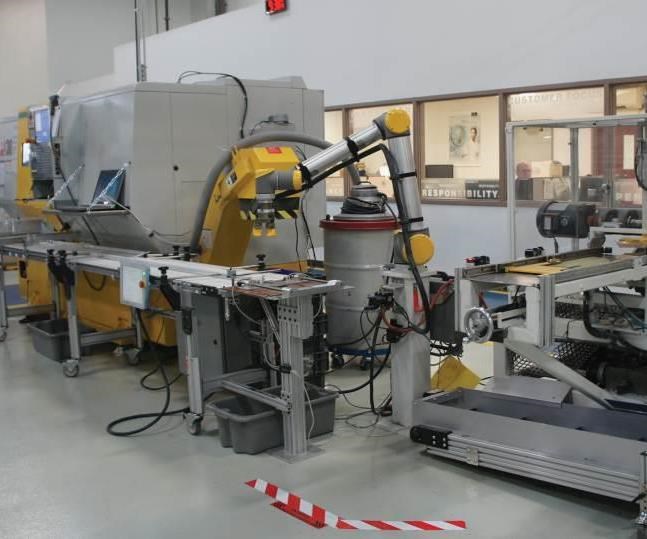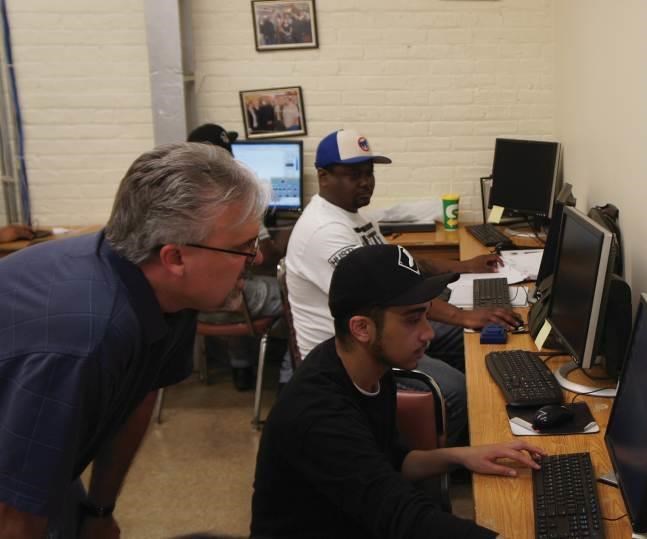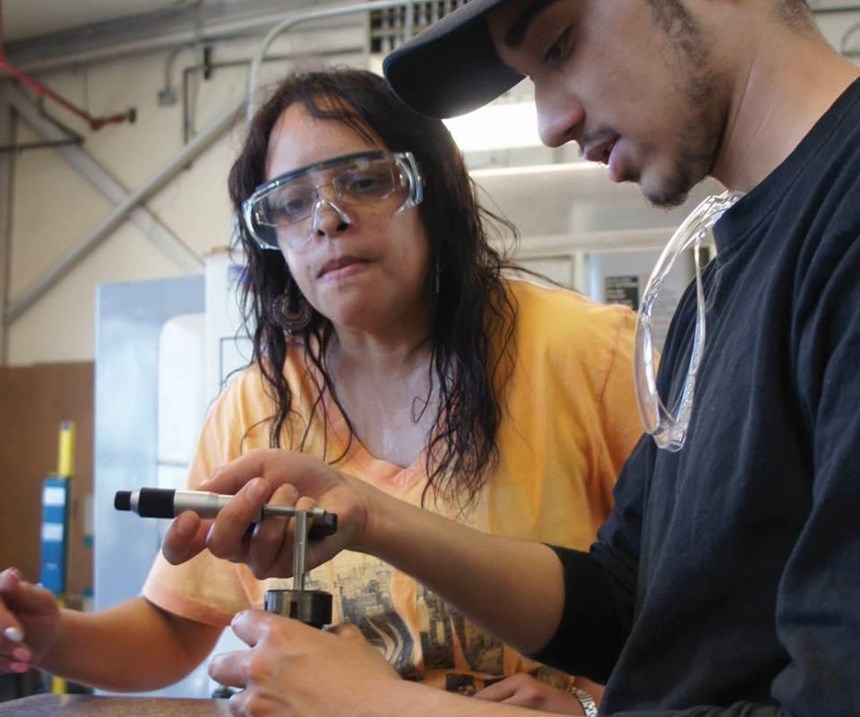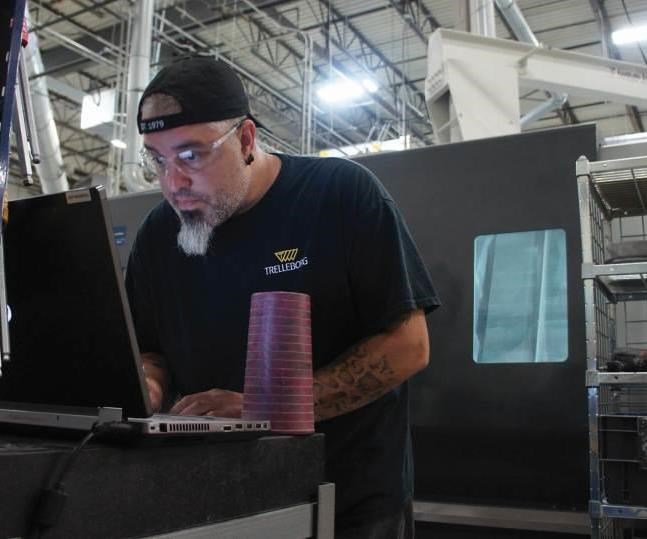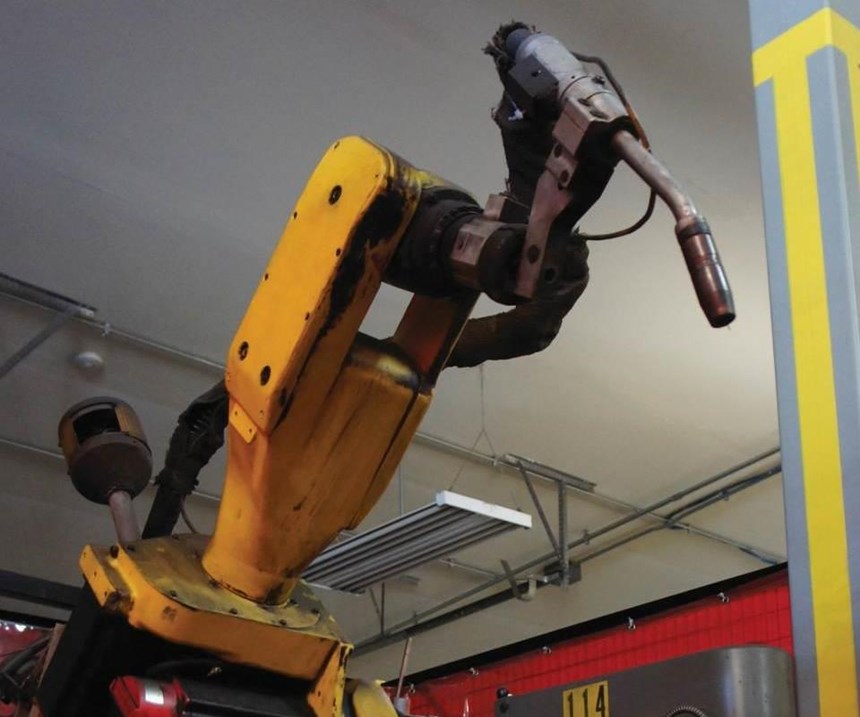Skills Training Strengthens Shops, Communities
A poverty-fighting nonprofit serves regional manufacturers as both a pipeline of fresh recruits and an incubator of existing talent.
For three straight years, Seneca Speight didn’t have a job. Not a regular one, anyway, the Chicagoan explains, recalling the uncertainty accompanying sporadic work sourced through temporary placement agencies. He didn’t have a car, either, among other barriers to full employment. Negativity came easy, and reasons for optimism seemed scarce.
These days, income is steady. A daily 28-mile commute takes him from his home in the city to the village of Streamwood, where, as pictured above, he works as a machinist, cutting injection-molded parts to specification at a satellite facility of global sealing component manufacturer Trelleborg Sealing Solutions. Five years after embarking on this new career path with zero manufacturing experience, Mr. Speight says life is very different. He’s happier and more secure, and he is even considering moving out of his apartment and buying a house. He enjoys his job, too. “I like working with my hands,” he says. “I feel good about saying, ‘I made that.’ I like learning. Machining, writing programs—all that is fun to me.”
Carl Ollerer, human resource manager, says Mr. Speight’s contribution goes beyond being one of the few machinists trusted with the large, valuable components that run on the facility’s last-remaining manual lathe. He’s also eager to volunteer when opportunities arise to take on new challenges, having transitioned through multiple CNC machining positions and even a stint on an injection molding machine at the 80-employee plant. “He’s always learning new things and developing his skills,” Mr. Ollerer says.
Mr. Speight is one of seven current Trelleborg employees trained by and recruited from the Jane Addams Resource Corp. (JARC), a local nonprofit that aims to ensure that people who are willing to work do not live in poverty. To that end, the organization works to prepare the financially disadvantaged for not just any jobs, but for good jobs—jobs that pay well, require no small degree of skill, offer room to advance, and are in high demand. More specifically, for manufacturing jobs.
What makes JARC different in the manufacturing training space goes beyond altruism. It also goes beyond the organization’s focus on soft skills and work readiness in addition to technical skills. Likewise for an open enrollment model that helps respond nimbly to demand and makes training feel more like a job than a class. In addition to all that, JARC stands out for its willingness to engage potential employers on needs specific to their own shop floors. That includes providing on-site training of existing workforces, leveraging a manufacturer’s own parts and equipment in targeted, customized programs that, at least for Trelleborg, have proven to be both performance-effective and cost-effective. “A partner like JARC is hard to find,” Mr. Ollerer says.
Playing Matchmaker
Mr. Ollerer’s use of the term “partner” is no accident. Guy Loudon, executive director of JARC, says the organization has been working to foster close relationships with companies like Trelleborg Americas for more than 30 years.
At the time of its founding in 1985, JARC focused on developing commercial property for industrial use and training existing workforces, Mr. Loudon says. Leveraging public funding to improve skill sets on the shop floor, the organization aimed to prevent layoffs and slow the exodus of manufacturing jobs in and around the industrial corridor of Ravenswood on the North Side of Chicago. However, the focus soon expanded. Even as the manufacturers who managed to hang on struggled with serious skills gaps, the broader community struggled with a growing income gap. For an organization founded on the idea that manufacturing training can strengthen families, communities and the overall economy, linking the two problems wasn’t much of a leap.
By the mid ‘90s, JARC had opened its first training center in Ravenswood. Given the organization’s sectoral approach (that is, a focus on the current needs of a specific industry), its Careers in Manufacturing programs are organized into specific tracks. As of the mid-2000s, these include CNC machining (milling and turning, a 500-hour, 20-week program), CNC press brake (10 weeks, 250 hours), and welding (14 weeks, 75 hours of MiG or TiG). The curricula are informed by an industry advisory council of representatives from employer partners (including Mr. Ollerer). Graduates receive certifications from either the National Institute for Metalworking Skills (NIMS) or the American Welding Society (AWS). In any given year, the company graduates between 80 and 100 people and conducts on-site training for existing workforces at about 20 different companies, Mr. Loudon says. (These figures account for both the Chicago area and Baltimore, where the organization expanded in 2015).
Breaking All Barriers
Lifting people out of poverty requires instilling more than just the technical skills they’ll need on the job. JARC support also continues until the graduate finds employment, largely through a specific team of matchmakers who visit employer partners and recommend candidates for specific positions. “We don’t graduate people just to graduate them,” Mr. Loudon says. “We want them to be financially self-sufficient.”
Given that more than 90 percent of JARC graduates secure full-time employment, the organization has largely been successful. Specific means to this end include the following:
• Treating trainees like employees. A core philosophy of JARC is that training shouldn’t feel like training; it shouldn’t feel like a school. “It’s more of a simulated work environment,” Mr. Loudon says. “Soft skills are embedded.”
This is facilitated largely through year-round open enrollment. That is, there are no semesters or other specified schedule, and anyone who meets entry requirements can join at any time. All trainees are still exposed to and tested on the same material, but each is responsible for his or her own progression through the projects outlined in training modules and submodules, much as they would be on the job.
There’s no room to slack off. Everyone is expected to punch in on time, and the program’s many group sessions and projects wait for no one. If a topic seems out of reach, trainees are expected to take notes, ask questions and work with more experienced peers in preparation for the day when the material is more accessible, then return to working on individual goals. Modules are often completed out of order, and some people outpace others.
This model benefits employers, too, Mr. Loudon adds, pointing out that there’s no need to wait for a specific graduation date to start looking at potential recruits. It’s also particularly well-suited for the economically disadvantaged—say, a single mother whose schedule might be tight during the school year. Once training begins, part-time scheduling is available to make it as accessible as possible. Many trainees with part-time jobs or other obligations attend only two or three of the five weekly sessions in any given track.
• Helping anyone willing to work. JARC works best for those who start with a real desire to take positive action and change their lives for the better, Mr. Loudon says. To that end, group orientation sessions, tours and interviews help single out who’s truly interested in being a part of the program. Yet, however motivated incoming candidates may be, many need more basic education before starting on their NIMS or AWS certifications. Companies like Trelleborg generally ask for at least a sixth-grade reading level and a ninth-grade math level, requirements that roughly half of JARC applicants in any given year don’t meet.
However, JARC never turns away candidates for lack of education, Mr. Loudon says. The
organization’s Manufacturing Bridge program provides general adult education to ensure that a sufficiently motivated trainee can always come away with something, even if he or she never moves on to technical skills training. This 120-hour bridge to technical training is also aptly named. For instance, reading classes have students poring over part blueprints, while math classes are supplemented with hands-on, shopfloor caliper measurements to drive home lessons on levels on average decimals, fractions and trigonometry. Mr. Loudon believes this added context is one reason why the bridge program improves graduates’ math and reading skills by an average of four grade levels in 12 weeks.
• Clearing a path for employment. Lack of education and technical skills aren’t the only hurdles to full employment and self-sufficiency for JARC trainees. As mentioned earlier, Mr. Speight didn’t have transportation when he first enrolled, so the organization’s Center for Working Families supplied him with bus passes to ensure he could make the trip across the city. Once he’d been hired at Trelleborg, JARC helped him purchase steel-toed boots and other basic necessities for earning his first paycheck.
Other aid facilitated by the organization includes mock interviews, resume building, counseling, financial coaching, debt payments and, particularly, legal assistance. As for the latter, the nonprofit “does a pretty good job of helping people make a U-turn when they want to,” Mr. Loudon says. As evidence, he points out that graduates with criminal records generally out-place and out-retain those without in any given year.
On the Shop Floor
The work that goes into preparing people for work is largely invisible for companies like Trelleborg. Mr. Ollerer says employer partners certainly aren’t pressured to provide any special treatment once a candidate is hired, at least not based on his experience with hiring 19 graduates during the past six years. In fact, things generally go more smoothly than with traditional means of finding employees. Recruits from the organization are more likely to stick around, too, with a roughly 50 percent retention rate that exceeds all other sources of talent.
JARC graduates are never just names on resumes, he explains. By the time they come in for interviews, they’ve already been vetted. They’ve already been projected to mesh well with the company’s culture, and to possesses the patience and attention to detail required to oversee repeated, high-production runs on CNC lathes. Granted, a NIMS certification is the entry-level minimum requirement for positions at Trelleborg. But these employees can, in a sense, grow into their own on their own, open-minded and unencumbered by preconceived notions of what the job should entail or how exactly to go about it.
Moreover, the company’s investment in JARC’s onsite training provides plenty of fresh educational opportunities for new and existing employees alike. “We came to realize that we have to focus on more than just finding people; we have to grow our own as well,” Mr. Ollerer says about the plant’s initial attraction to JARC. “When you give an entry-level person training, when you invest in that person, they’re more likely to be committed to your organization.”
On-site training with a new partner often begins with a suite of diagnostic tools, including both written and hands-on assessments, to determine the current level of skill on the shop floor, Mr. Loudon says. This helps determine a starting point for specific curricula—say, JARC’s “CNC 2” module. However, it’s largely up to the manufacturer to outline the specifics of what training should accomplish. JARC, meanwhile, helps work out the details and commissions a suitable instructor, whether someone on staff or a contracted industry expert.
Trelleborg has commissioned at least one such program per year during its six-year relationship with JARC, and some years have seen as many as three, Mr. Ollerer says. Programs generally last about eight weeks and are conducted in half-day sessions on the weekend to avoid disrupting production (employees are, of course, paid for this time). Training generally targets specific groups of eight to 10 people. For instance, one past program focused on teaching Mazak’s conversational programming system to Haas machine operators. Examples of training JARC has conducted at other manufacturing partners range from instruction in lean manufacturing tools like 5S to ISO certification to safety-related issues.
Customization isn’t the only advantage of this on-site training. Using the company’s own parts, equipment and standard operating procedures makes even the most generic JARC training more effective than other options, Mr. Ollerer says. Courses have been cost-effective, too, he says, historically ranging anywhere from $4,000 to $8,000. Emphasizing that the hourly rate depends largely on the instructor, and that the ongoing fiscal situation in Illinois has made public funding more difficult to secure, Mr. Loudon attributes low costs to the organization’s nonprofit status and 100 percent fee-for-service model.
A Model to Emulate?
JARC recently expanded its Careers in Manufacturing programs to two additional Chicago-area locations: DuPage County in 2014 and the west side neighborhood of Austin last fall. In 2015, the organization expanded beyond Chicago for the first time, opening a branch in Baltimore, Maryland, that has only recently begun providing training for existing workforces in addition to jobseekers. Expanding support for JARC is also reflected in the organization’s budget, which has grown from slightly more than $1 million to more than $4 million during the past five-odd years.
Mr. Loudon attributes this success to a variety of factors, including more positive views of manufacturing and a substantial boost in support from charitable foundations. Still, operating as a non-profit can be difficult for an organization focused on manufacturing skills training, he says. For instance, operational costs and salaries can be paid with public funds, but capital equipment upgrades often require support from trade associations or employer partners. Even something like a broken cutting tool can disrupt proceedings far more than it likely would for a typical machine shop, he adds. This limitation is also the reason why all expansion to date has depended on partnerships with other organizations and the availability of existing training infrastructure.
Whatever the future extent of JARC’s success, a single regional organization can go only so far in addressing the problems of an entire industry. For his part, Mr. Loudon says he’s happy to evangelize JARC’s model to anyone willing to listen. “Scaling our impact doesn’t depend solely on expansion,” he says. “It also means distilling and sharing what we consider to be best practices with others. A simulated work environment, project-based instruction, the use of industry credentials, training by industry pros, sensitivity toward the need for bundled services and bridge programming—those are the core ideas we’re organizing around. Take that to your community college; take that to your workforce development board.”
Related Content
How to Pass the Job Interview as an Employer
Job interviews are a two-way street. Follow these tips to make a good impression on your potential future workforce.
Read MoreCan Connecting ERP to Machine Tool Monitoring Address the Workforce Challenge?
It can if RFID tags are added. Here is how this startup sees a local Internet of Things aiding CNC machine shops.
Read MoreThe Power of Practical Demonstrations and Projects
Practical work has served Bridgerland Technical College both in preparing its current students for manufacturing jobs and in appealing to new generations of potential machinists.
Read MoreHow I Made It: Amy Skrzypczak, CNC Machinist, Westminster Tool
At just 28 years old, Amy Skrzypczak is already logging her ninth year as a CNC machinist. While during high school Skrzypczak may not have guessed that she’d soon be running an electrical discharge machining (EDM) department, after attending her local community college she found a home among the “misfits” at Westminster Tool. Today, she oversees the company’s wire EDM operations and feels grateful to have avoided more well-worn career paths.
Read MoreRead Next
IMTS 2024: Trends & Takeaways From the Modern Machine Shop Editorial Team
The Modern Machine Shop editorial team highlights their takeaways from IMTS 2024 in a video recap.
Read MoreInside Machineosaurus: Unique Job Shop with Dinosaur-Named CNC Machines, Four-Day Workweek & High-Precision Machining
Take a tour of Machineosaurus, a Massachusetts machine shop where every CNC machine is named after a dinosaur!
Read MoreThe Future of High Feed Milling in Modern Manufacturing
Achieve higher metal removal rates and enhanced predictability with ISCAR’s advanced high-feed milling tools — optimized for today’s competitive global market.
Read More

